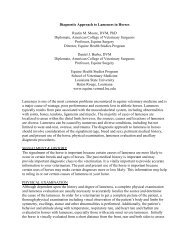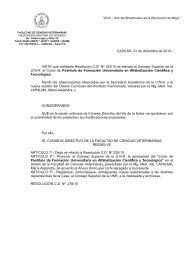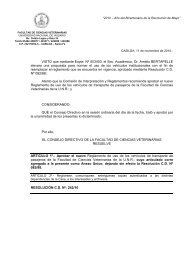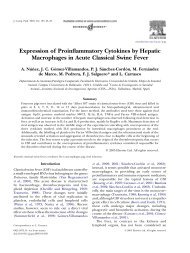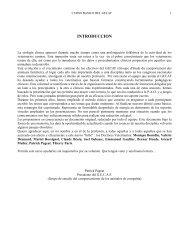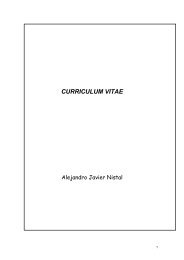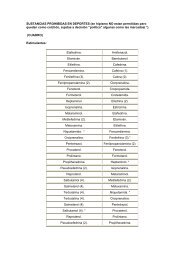Normal Respiratory Values
Normal Respiratory Values
Normal Respiratory Values
You also want an ePaper? Increase the reach of your titles
YUMPU automatically turns print PDFs into web optimized ePapers that Google loves.
AIn: Equine <strong>Respiratory</strong> Diseases, Lekeux P. (Ed.). International Veterinary<br />
Information Service, Ithaca NY (www.ivis.org), 22-Apr-2005; B0341.0405<br />
<strong>Normal</strong> <strong>Respiratory</strong> <strong>Values</strong><br />
E. Van Erck, T. Art and P. Lekeux<br />
Department of Physiology and Sport Medicine, Faculty of Veterinary Medicine,<br />
University of Liège, Liège, Belgium.<br />
Conversion Table for Common <strong>Values</strong><br />
Data SI Units* Other Units<br />
Pressure 1 kPa 7.5 mmHg<br />
1 kPa 10.2 cmH2O<br />
1 kPa 10 mbar<br />
1 kPa 0.0099 atm<br />
1 kPa 0.1 N/cm 2<br />
Work 1 J 0.239 cal<br />
1 J 10.2 cmH2O.cm 2<br />
Power 1 W 0.0143 kcal/min<br />
Gas exchange 1 mmol/min 22.4 ml/min<br />
Gas content 1 mmol/liter 2.24 ml/dl<br />
Hemoglobin 1 mmol/liter 16.1 g/liter<br />
*SI Units = International System of Units.<br />
Other conversion tables are available at:<br />
www.digitaldutch.com/unitconverter<br />
www.onlineconversion.com<br />
www.megaconverter.com/mega2<br />
1. <strong>Normal</strong> Ventilation <strong>Values</strong><br />
1.1. <strong>Normal</strong> Ventilation <strong>Values</strong> in Adult Horses<br />
Mean ventilation values in healthy Thoroughbred horses considered average for their<br />
quality, fitness, age (5 years), and size (mean body weight 470 kg) and running on a<br />
treadmill under temperature climatic conditions (lung and gas volumes are expressed as<br />
BTPS and STPD respectively). Measurements were made at 6 m/s at walk (duration: 5<br />
minutes), 3.4 m/s at trot (duration: 5 minutes), 8 m/s at canter (duration: 1 minute) and<br />
10 m/s with 4% slope incline at gallop (duration: 1 minute) and 5 minutes after recovery<br />
[1].<br />
Value Unit Rest Walk<br />
Slow<br />
Trot<br />
Canter Fast Gallop Recovery
Value Unit Rest Walk<br />
Slow<br />
Trot<br />
Canter Fast Gallop Recovery<br />
VO2max% % 3.3 14 18 60 100 20<br />
VT liters 5.6 5.8 6.2 9.2 13.2 6.5<br />
VD liters 3.4 3.4 3.5 2.6 2.6 3.5<br />
VA liters 2.2 2.4 2.8 6.6 10.6 3.0<br />
VD/VT % 60 58 57 28 20 54<br />
f breaths/min 14 65 91 113 121 110<br />
ti seconds 1.9 0.45 0.34 0.27 0.25 0.29<br />
te seconds 2.4 0.47 0.32 0.27 0.25 0.26<br />
ti/ttot % 44 49 52 50 50 53<br />
E<br />
D<br />
A<br />
E/VO2<br />
E/VCO2<br />
mean i<br />
mean e<br />
imax<br />
emax<br />
i<br />
e<br />
liters/min 78 377 564 1040 1598 715<br />
liters/min 47 219 321 291 320 386<br />
liters/min 31 158 243 749 1278 329<br />
liters/liter 35 40 47 26 24 55<br />
liters/liter 43 48 51 27 23 51<br />
liters/s 2.9 13 19 34 53 26<br />
liters/s 2.3 12 20 34 53 30<br />
liters/s 4.1 14 27 45 64 32<br />
liters/s 4.2 18 30 52 79 39<br />
liters/s 2<br />
liters/s 2<br />
8 240 632 1124 1685 650<br />
7 225 566 1086 1595 744<br />
VO2max %: percent of maximal oxygen uptake; VT: tidal volume; VD: physiological dead space; VA:<br />
alveolar volume; VD/VT: ratio of dead space to tidal volume; f: breathing frequency; ti: inspiratory<br />
time of the breathing cycle; te: expiratory time; ti/ttot: ratio of inspiratory to total time of the<br />
breathing cycle; E: minute volume; D: dead space ventilation; A: alveolar<br />
ventilation; E/VO2: ventilatory equivalent for oxygen uptake; E/VCO2: ventilatory<br />
equivalent for carbon dioxide output; mean i: mean inspiratory flow or inspiratory drive; mean<br />
e: mean expiratory flow; imax: peak inspiratory flow; emax: peak expiratory flow;<br />
i: volume acceleration at the onset of inspiration; e: volume acceleration at the onset of
Value Unit Rest Walk<br />
expiration.<br />
1.2. <strong>Normal</strong> Ventilation in Neonate Foals<br />
Slow<br />
Trot<br />
Canter Fast Gallop Recovery<br />
Ventilatory parameters and pressure changes during normal tidal breathing in the standing<br />
foal less than 1 week of age [2,3]<br />
Age in<br />
Days<br />
n VT (L)<br />
2 7<br />
0.65 ±<br />
0.15<br />
7 9<br />
0.90 ±<br />
0.17<br />
<strong>Values</strong> are means ± s.d.<br />
VT/kg<br />
(ml/kg)<br />
15.8 ± 2.5<br />
17.6 ±3.0<br />
f (bpm) E<br />
E/kg<br />
(L/min) (ml/kg)<br />
53.9 ±<br />
9.9<br />
34.8 ± 12.0 848 ± 231<br />
40.9 ±<br />
5.2<br />
33.9 ± 7.5 717 ± 157<br />
Ti (sec) Te (sec)<br />
0.51 ±<br />
0.15<br />
0.65 ±<br />
0.10<br />
0.72 ±<br />
0.09<br />
0.75 ±<br />
0.17<br />
VT: tidal volume; f: frequency of breathing, bpm: breaths per minute; E: minute ventilation; Ti:<br />
inspiratory time; Te: expiratory time.<br />
2. <strong>Normal</strong> <strong>Values</strong> of Breathing Mechanics<br />
2.1. <strong>Normal</strong> <strong>Values</strong> of Breathing Mechanics in Adult Horses<br />
Mean ventilation values in healthy Thoroughbred horses considered average for their<br />
quality, fitness, age (5 years), and size (mean body weight 470 kg) and running on a<br />
treadmill under temperature climatic conditions (lung and gas volumes are expressed as<br />
BTPS and STPD respectively). Measurements were made at 6 m/s at walk (duration: 5<br />
minutes), 3.4 m/s at trot (duration: 5 minutes), 8 m/s at canter (duration: 1 minute) and<br />
10 m/s with 4% slope incline at gallop (duration: 1 minute) and 5 minutes after recovery<br />
[1].<br />
Value Unit Rest Walk Slow Trot Canter Fast Gallop Recover 5'<br />
Ppl min kPa -0.78 -1.19 -1.78 -3.19 -4.85 -1.68<br />
Ppl max kPa -0.34 0.31 0.55 2.42 3.62 0.53<br />
MaxΔPpl kPa 0.44 1.50 2.33 5.61 8.47 2.21<br />
Pin kPa 0.02 0.54 1.16 2.61 4.26 1.71<br />
ΔPV = 0 kPa 0.24 -0.29 -0.90 -2.42 -3.88 -1.90<br />
Cdyn liter/kPa 23 -20 -6.8 -3.8 -3.4 -3.4<br />
RL Pa/liter/s 25 26 30 48 57 27<br />
RUA Pa/liter/s 20 21 23 38 46 21<br />
RLA Pa/liter/s 5 5 7 10 11 6<br />
Wvis J 1.4 6.2 14 36 82 14<br />
vis<br />
J/min 17 403 1274 4068 9922 1540
Value Unit Rest Walk Slow Trot Canter Fast Gallop Recover 5'<br />
vis/VE<br />
vis/VO2<br />
J/min 0.22 1.07 2.2 3.9 6.2 2.2<br />
J/liter 7.7 42 106 102 148 118<br />
Ppl min: peak intrapleural pressure recorded during inspiration; Ppl max: peak intrapleural pressure<br />
recorded during expiration; maxΔPpl: maximum change in intrapleural pressure; Pin: initial pressure;<br />
ΔPV=0: intrapleural pressure gradient between the 2 points of zero flow; Cdyn: dynamic lung<br />
compliance; RL: total pulmonary resistance; RUA: upper airways resistance; RLA: lower airways<br />
resistance; vis: viscous work of breathing; vis: minute work of breathing; vis/VE:<br />
work of breathing per ventilated liter; vis/VO2: work of breathing per liter of oxygen uptake.<br />
2.2. <strong>Normal</strong> <strong>Values</strong> of Impulse Oscillometry Mechanics in Adult Horses<br />
<strong>Values</strong> of respiratory resistance (Rrs) measured from 5 to 35 Hz with<br />
the Impulse Oscillometry System (IOS) [4]<br />
Rrs (kPa/l/s) Mean SD CLL CLU<br />
R5Hz 0.070 0.012 0.066 0.074<br />
R10Hz 0.081 0.011 0.077 0.085<br />
R15Hz 0.088 0.012 0.085 0.092<br />
R20Hz 0.079 0.010 0.076 0.083<br />
R25Hz 0.075 0.010 0.072 0.078<br />
R35Hz 0.062 0.009 0.059 0.065<br />
SD: Standard deviation, CLL: 95% lower confidence limit, CLU: 95% upper<br />
confidence limit<br />
<strong>Values</strong> of reactance (Xrs) measured from 5 to 35 Hz with the Impulse<br />
Oscillometry System (IOS) [4]<br />
Xrs (kPa/l/s) Mean SD CLL CLU<br />
X5Hz 0.020 0.007 0.017 0.022<br />
X10Hz 0.015 0.009 0.012 0.018<br />
X15Hz 0.009 0.012 0.005 0.013<br />
X20Hz 0.006 0.015 0.001 0.010<br />
X25Hz 0.003 0.013 -0.001 0.008<br />
X35Hz -0.003 0.010 -0.007 0.000<br />
SD: Standard deviation, CLL: 95% lower confidence limit, CLU: 95% upper<br />
confidence limit<br />
3. <strong>Normal</strong> Gas Exchange <strong>Values</strong><br />
3.1. <strong>Normal</strong> <strong>Values</strong> of Blood Gases in Adult Horses
PaO2 85 - 105 mmHg<br />
PaCO2 42 - 46 mmHg<br />
pH 7.38 - 7.42<br />
Mean ventilation values in healthy Thoroughbred horses considered average for their<br />
quality, fitness, age (5 years), and size (mean body weight 470 kg) and running on a<br />
treadmill under temperature climatic conditions (lung and gas volumes are expressed as<br />
BTPS and STPD respectively). Measurements were made at 6 m/s at walk (duration: 5<br />
minutes), 3.4 m/s at trot (duration: 5 minutes), 8 m/s at canter (duration: 1 minute) and<br />
10 m/s with 4% slope incline at gallop (duration: 1 minute) and 5 minutes after recovery<br />
[1].<br />
Value Unit Rest Walk Slow Trot Canter Fast Gallop Recover 5'<br />
O2<br />
ml/kg/min 4.7 20.2 25.5 85.1 142.5 27.7<br />
CO2<br />
ml/kg/min 3.8 17.0 23.4 80.9 146.8 29.8<br />
R - 0.82 0.85 0.92 0.95 1.03 1.07<br />
Venous PO2 mmHg 39 32 30 25 16 62<br />
Venous PCO2 mmHg 47 49 50 64 96 43<br />
HCO3 -<br />
mmol/liter 28.8 28.9 27.5 26.6 23.0 19.2<br />
Arterial PO2 mmHg 95 101 99 83 69 115<br />
Arterial PCO2 mmHg 45 44 43 46 50 32<br />
(A-a) ΔO2 mmHg 4 2 4 16 29 6<br />
pHa - 7.39 7.40 7.40 7.39 7.26 7.36<br />
PCV % 38 42 44 48 58 56<br />
Hb G/liter 140 150 160 175 220 220<br />
Arterial SO2 % 97 97.5 97 95 90 98.5<br />
Arterial CO2 liter% 20 22 22 25 28 33<br />
Venous CO2 liter% 14 11 11 7 5 21<br />
C(a-v)O2 liter% 6 11 11 18 23 12<br />
Alveolar PO2 mmHg 99 103 103 99 98 121<br />
Alveolar PCO2 mmHg 44 43 42 45 49 31<br />
FmeO2 % 16.2 17.0 17.7 14.9 14.3 18.4<br />
FmeCO2 % 2.6 2.6 2.5 4.6 5.4 2.1<br />
FetO2 % 14.0 14.5 14.5 13.9 13.9 17.2<br />
FetCO2 % 6.3 6.1 6.0 6.4 7.0 4.5<br />
O2: oxygen uptake; CO2: carbon dioxide output; R: respiratory exchange ratio; venous<br />
PO2: venous oxygen partial pressure; venous PCO2: venous carbon dioxide partial pressure; arterial<br />
PO2: arterial oxygen partial pressure; arterial PCO2: arterial carbon dioxide partial pressure; HCO3 - :<br />
bicarbonate content; [A-a] ΔO2: alveolar-arterial oxygen gradient; pHa: arterial pH; PCV: packed<br />
cell volume; Hb: blood hemoglobin concentration; arterial SO2: percent saturation of hemoglobin<br />
with oxygen; arterial CO2: arterial oxygen content; venous CO2: venous oxygen content; C(a-v)O2:<br />
arteriovenous oxygen content gradient; alveolar PO2: alveolar oxygen partial pressure; alveolar
PCO2: alveolar carbon dioxide partial pressure; FmeO2: mixed expired oxygen fraction; FmeCO2:<br />
mixed expired carbon dioxide fraction; FetO2: end-tidal oxygen fraction; FetCO2: end-tidal carbon<br />
dioxide fraction.<br />
3.2. <strong>Normal</strong> <strong>Values</strong> of Arterial Blood Gases in Foals<br />
Gestational<br />
Age/Status<br />
<strong>Values</strong> measured from birth until 1 week (expressed as mean ± SEM)<br />
Postnatal<br />
Age<br />
<strong>Normal</strong> 3 - 168 hr Lateral<br />
<strong>Normal</strong><br />
1 - 12 hr<br />
12 - 48 hr<br />
48 - 168 hr<br />
Position pH<br />
Lateral<br />
<strong>Normal</strong> 4 - 11 hr Lateral<br />
<strong>Normal</strong><br />
24 hr<br />
24 hr<br />
48 hr<br />
48 hr<br />
72 hr<br />
72 hr<br />
144 hr<br />
144 hr<br />
Standing<br />
Lateral<br />
Standing<br />
Lateral<br />
Standing<br />
Lateral<br />
Standing<br />
Lateral<br />
Premature 0.5 - 11 hr Lateral<br />
Term<br />
Birth<br />
2 min<br />
15 min<br />
30 min<br />
60 min<br />
2 hr<br />
4 hr<br />
12 hr<br />
24 hr<br />
48 hr<br />
96 hr<br />
Lateral<br />
Lateral<br />
Lateral<br />
Lateral<br />
Lateral<br />
Lateral<br />
Lateral<br />
Lateral<br />
Lateral<br />
Lateral<br />
Lateral<br />
7.354 ±<br />
0.011<br />
7.378 ±<br />
0.015<br />
3.374 ±<br />
0.004<br />
7.384 ±<br />
0.014<br />
7.367 ±<br />
0.10<br />
7.41 ± 0.03<br />
7.38 ± 0.05<br />
7.40 ± 0.03<br />
7.37 ± 0.00<br />
7.39 ± 0.07<br />
7.44 ± 0.14<br />
7.42 ± 0.03<br />
7.41 ± 0.03<br />
7.208 ±<br />
0.48<br />
7.413 ±<br />
0.019<br />
7.312 ±<br />
0.016<br />
7.322 ±<br />
0.025<br />
7.354 ±<br />
0.010<br />
7.362 ±<br />
0.013<br />
7.362 ±<br />
0.012<br />
7.355 ±<br />
0.017<br />
7.357 ±<br />
0.024<br />
7.393 ±<br />
0.012<br />
PaCO2<br />
mmHg<br />
PaO2<br />
mmHg HCO3 n Ref<br />
47.5 ± 2.6 80.0 ± 3.8 10 [5]<br />
42.2 ± 1.8<br />
44.5 ± 1.2<br />
42.4 ± 1.0<br />
77.3 ± 3.1<br />
83.2 ± 3.1<br />
88.2 ± 5.9<br />
6<br />
6<br />
5<br />
[6]<br />
39.5 ± 1.8 83.8 ± 6.3 5 [7]<br />
45.2 ± 2.5<br />
48.1 ± 3.8<br />
47.5 ± 3.7<br />
49.5 ± 2.8<br />
49.6 ± 1.5<br />
51.6 ± 7.2<br />
47.3 ± 2.3<br />
46.9 ± 2.1<br />
84.6 ± 6.9<br />
72.69 ±<br />
14.2<br />
106.6 ± 3.9<br />
89.6 ± 12.7<br />
104.5 ± 4.8<br />
94.1 ± 4.3<br />
98.8 ± 4.8<br />
84.2 ± 6.9<br />
3<br />
3<br />
3<br />
3<br />
5<br />
5<br />
5<br />
5<br />
[8]<br />
55.3 ± 3.6 53.7 ± 1.5 7 [6]<br />
45.7 ± 1.1<br />
54.1 ± 2.0<br />
50.4 ± 2.7<br />
51.5 ± 1.5<br />
47.3 ± 2.2<br />
47.7 ± 1.7<br />
45.0 ± 1.9<br />
44.3 ± 1.2<br />
45.5 ± 1.5<br />
46.1 ± 1.1<br />
45.8 ± 1.1<br />
39.7 ± 2.1<br />
56.4 ± 2.3<br />
57.5 ± 3.6<br />
57.0 ± 1.8<br />
60.9 ± 2.7<br />
66.5 ± 2.3<br />
75.7 ± 4.9<br />
73.5 ± 3.0<br />
67.6 ± 4.4<br />
74.9 ± 3.3<br />
81.2 ± 3.1<br />
26.3 ±<br />
1.1<br />
24.0 ±<br />
1.2<br />
24.4 ±<br />
1.6<br />
25.3 ±<br />
0.7<br />
25.3 ±<br />
1.0<br />
25.0 ±<br />
0.9<br />
23.6 ±<br />
1.1<br />
23.2 ±<br />
1.3<br />
26.2 ±<br />
1.1<br />
8<br />
10<br />
9<br />
10<br />
9<br />
8<br />
10<br />
10<br />
9<br />
8<br />
8<br />
[9]
Gestational<br />
Age/Status<br />
<strong>Values</strong> measured from birth until 1 week (expressed as mean ± SEM)<br />
Postnatal<br />
Age<br />
4. Pulmonary Hemodynamics<br />
Position pH<br />
7.398 ±<br />
0.008<br />
7.396 ±<br />
0.012<br />
PaCO2<br />
mmHg<br />
PaO2<br />
mmHg HCO3<br />
25.7 ±<br />
0.6<br />
23.2 ±<br />
2.1<br />
n Ref<br />
Mean ventilation values in healthy Thoroughbred horses considered average for their<br />
quality, fitness, age (5 years), and size (mean body weight 470 kg) and running on a<br />
treadmill under temperature climatic conditions (lung and gas volumes are expressed as<br />
BTPS and STPD respectively). Measurements were made at 6 m/s at walk (duration: 5<br />
minutes), 3.4 m/s at trot (duration: 5 minutes), 8 m/s at canter (duration: 1 minute) and<br />
10 m/s with 4% slope incline at gallop (duration: 1 minute) and 5 minutes after recovery<br />
[1].<br />
Value Unit Rest Walk<br />
Slow<br />
Trot<br />
Canter Fast Gallop Recover 5'<br />
HR beats/min 35 75 103 155 210 83<br />
SV liters 1.05 1.07 1.12 1.39 1.36 1.32<br />
Q liters/min 37 80 115 215 285 110<br />
PaPmax mmHg 37 69 78 99 152 53<br />
PaPmin mmHg 22 30 39 47 50 26<br />
PaPm mmHg 28 43 52 65 82 35<br />
Pw mmHg 16 25 30 37 49 20<br />
P (aP-w) mmHg 12 18 22 28 33 15<br />
PVR mmHg/liter/min 0.32 0.22 0.19 0.13 0.11 0.14<br />
T°a °C 37.5 37.9 38.1 38.7 41.3 39.7<br />
O2/HR<br />
ml/kg/beat 0.06 0.25 0.25 0.55 0.68 0.34<br />
liters/liter 0.84 1.98 2.11 3.48 4.48 3.00<br />
A/Q<br />
HR: heart rate; SV: stroke volume; Q: cardiac output; PaPmax: maximal pulmonary artery pressure;<br />
PaPmin: minimal pulmonary artery pressure; PaPm: mean pulmonary artery pressure; Pw:<br />
pulmonary artery wedge pressure; P(aP-w): pulmonary driving pressure; PVR: pulmonary vascular<br />
resistance; T°a: arterial blood temperature; O2/HR: oxygen pulse; A/Q: global<br />
ventilation/perfusion ratio.<br />
References<br />
• 1. Lekeux P, Art T. The respiratory system: anatomy, physiology, and<br />
adaptations to exercise and training. In: Hodgson DR, Rose RJ. Eds. The athletic<br />
horse: principles and practice of equine sports medicine. Philadelphia: WB<br />
Saunders Company, 1994, pp 79-127. - Available from amazon.com -
• 2. Beech J. Equine respiratory disorders. Philadelphia: Lea & Febiger, 1999; 458<br />
pp.<br />
• 3. Koterba AM, Kosch PC. <strong>Respiratory</strong> mechanics and breathing pattern in the<br />
neonatal foal. J Reprod Fertil Suppl 1987; 35:575-585. - Pubmed -<br />
• 4. van Erck E, Votion D, Art T, et al. Measurement of respiratory function by<br />
impulse oscillometry in horses. Equine Vet J 2004; 36:21-28. - Pubmed -<br />
• 5. Rossdale PD. Some parameters of respiratory function in normal and<br />
abnormal newborn foals with special reference to levels of paO2 during air and<br />
oxygen inhalation. Res Vet Sci 1970; 11:270-276.<br />
• 6. Rose RJ, Rossdale PD, Leadon DP. Blood gas and acid--base status in<br />
spontaneously delivered, term-induced and induced premature foals. J Reprod<br />
Fertil Suppl 1982; 32:521-528. - Pubmed -<br />
• 7. Rose RJ, Hodgson DR, Leadon DP, et al. Effect of intranasal oxygen<br />
administration on arterial blood gas and acid base parameters in spontaneously<br />
delivered, term induced and induced premature foals. Res Vet Sci 1983; 34:159-<br />
162. - Pubmed -<br />
• 8. Madigan J, Thomas WP. Cardiopulmonary function in normal newborn foals<br />
from 1-14 days of age. Proc Am Coll Vet Int Med 1986; 10:101.<br />
• 9. Stewart JH, Rose RJ, Barko AM. <strong>Respiratory</strong> studies in foals from birth to<br />
seven days old. Equine Vet J 1984; 16:323-328. - Pubmed -<br />
Click on the author's name to view a list of his/her publications: E. Van Erck, T. Art and<br />
P. Lekeux



